
Ancestry DNA estimates that I am 31% and Heather is 10% Scottish. On the Fike side we have traced our ancestry back to three highland and two aristocratic clans. Highland clans are the older family groups descended from the Gaelic Scots before the Norman conquest of England in 1066. The aristocratic Scottish clans were formed by the Norman rulers of England and Scotland after they conquered the island and formed the new royal lines. In Scotland the new ruling families formed clan groups to conform to the local culture.
Our Highland Clans are MacLean, Mackintosh, and Ross. The Andrew family is descended from Clan Ross.
Through the MacKintosh clan chieftains we are descendants of the real life King Duncan who Shakespeare cast as the victim in “The Scottish Play” (Macbeth).

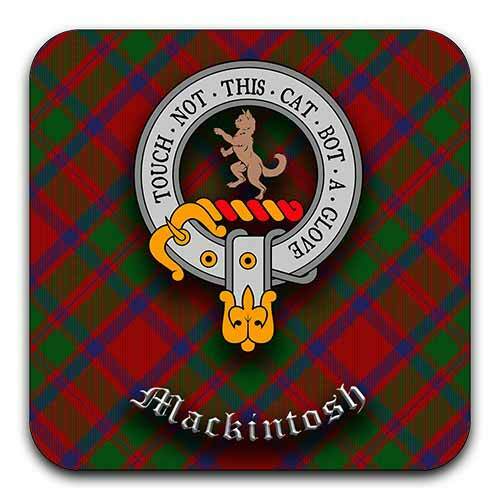
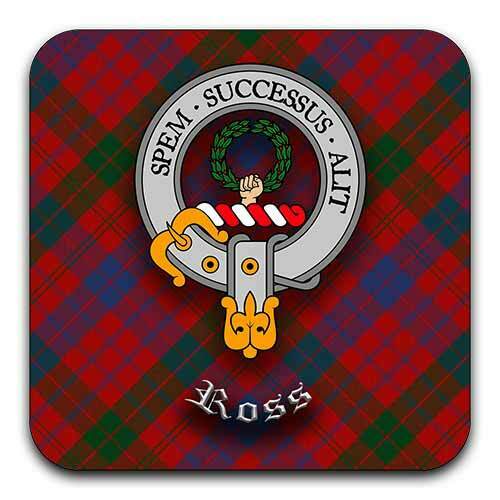
We are descended from the Bruce and Fleming aristocratic clans through the Farley’s of Virginia. You can follow this link to learn more about the Bruce and Fleming families in the section about our royal ancestry.
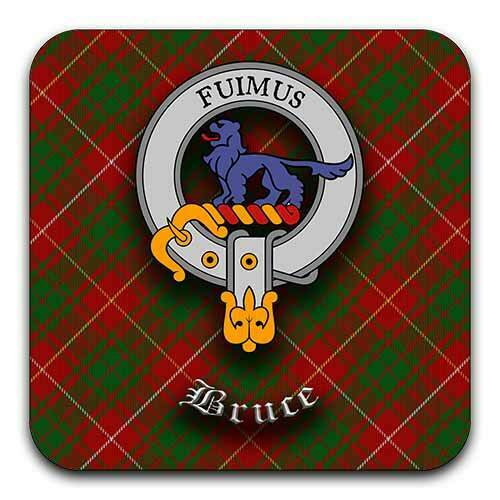
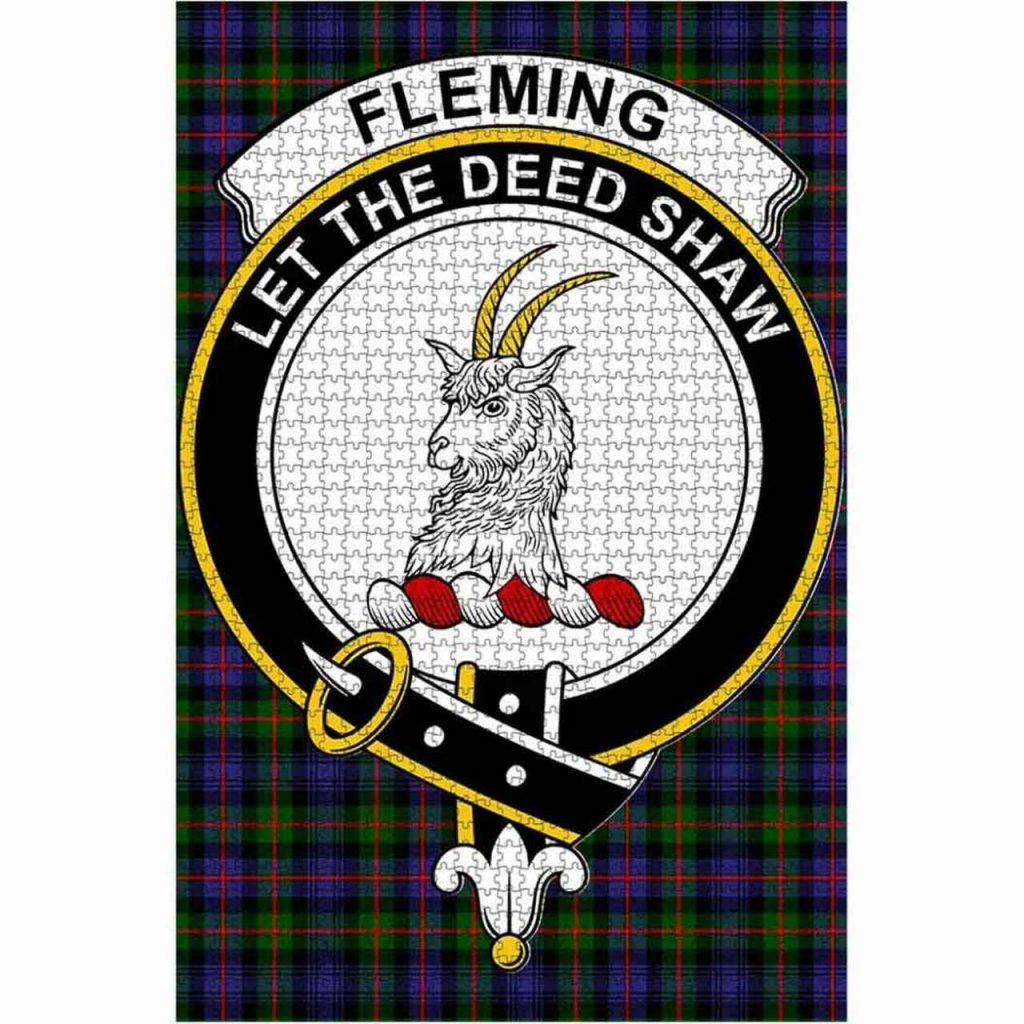
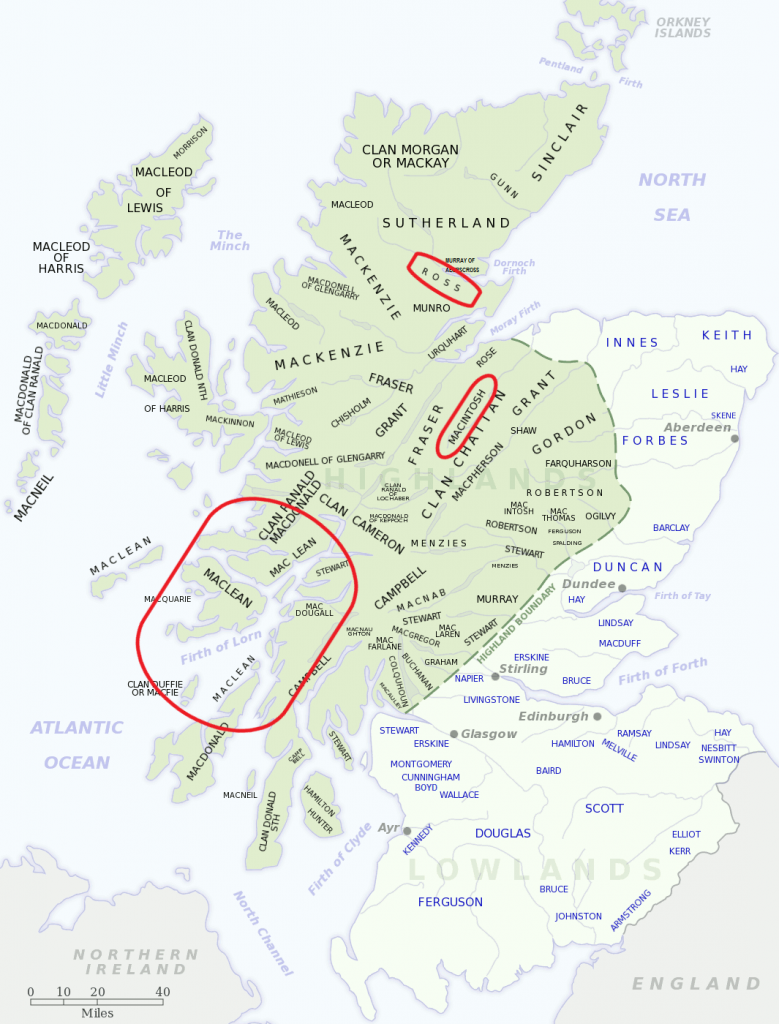
Clan MacLean
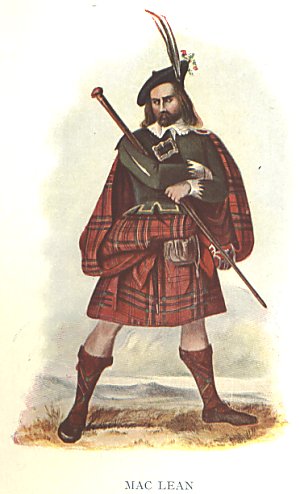
Daniel McLean (1823-1886), born at Dunoon, Argyle, Scotland emigrated to America settling in Utah. He was the 4th great-grandson of Donald MacLean 1st Lord of Brolass (1600–1655), born at Duart Castle, Isle of Mull, Scotland.

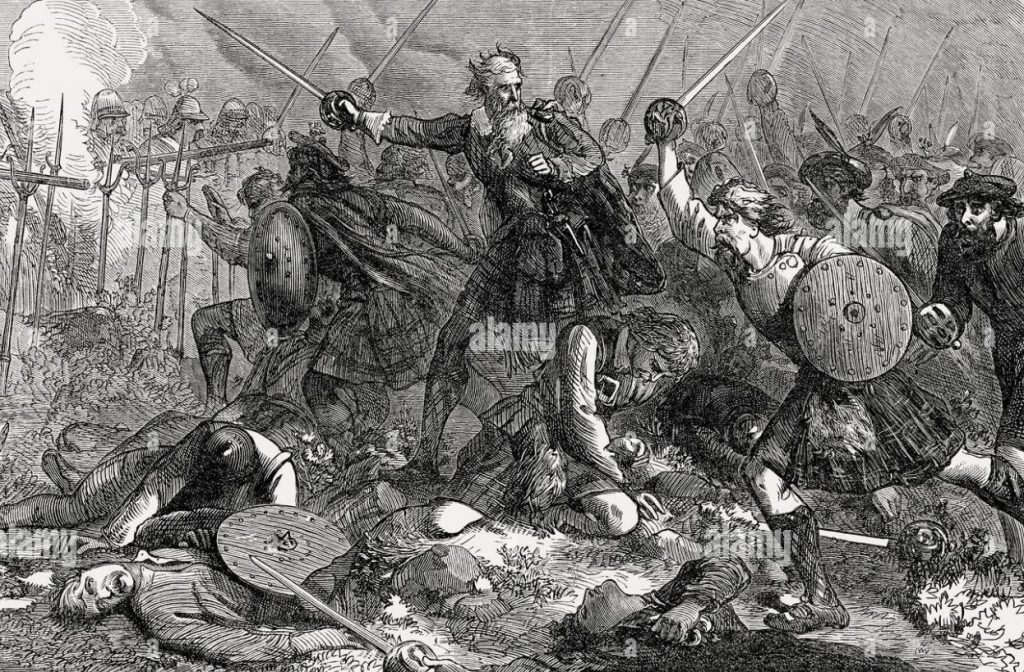
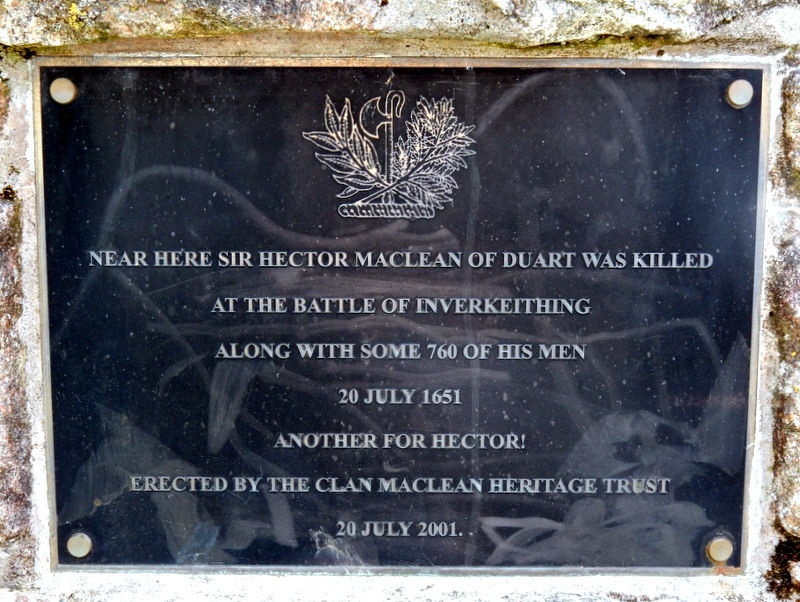
Donald MacLean, 1st Laird of Brolas (circa 1600–after 1655, born at Duart Castle), was a Scottish Laird of Clan MacLean who fought in the battle of Battle of Inverkeithing. He was the first Laird of Brolas. (My 9th great-grandfather)
His father was Hector Og Maclean (depicted in the painting), 15th Clan Chief and his mother was a daughter of Sir Archibald Acheson, 1st Baronet. Donald was the first son of Hector’s second marriage.
He married Florence Maclean, the daughter of John Garbh Maclean, 7th Laird of Coll one of their children was our ancestor Lauchlan Maclean, 2nd Laird of Brolas, who was the Member of Parliament for Argyllshire. His descendant, Sir Allan Maclean, 6th Baronet, became the Clan Chief when the previous chief died without an heir (Ancestor).
Clan MacKintosh
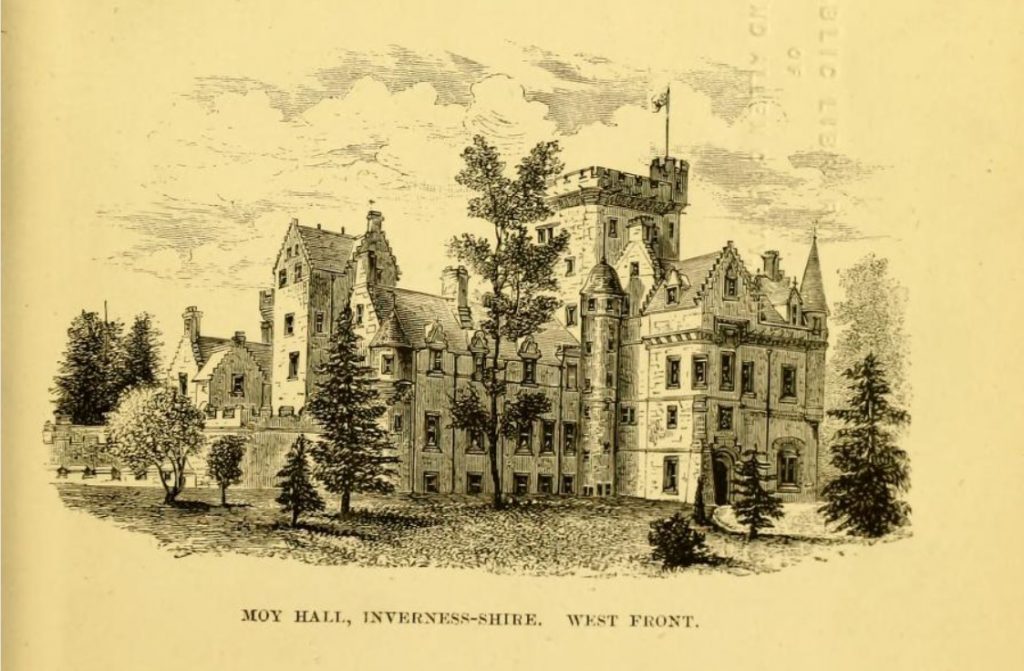

Malcolm Dunkeld Chief Van MacKintosh (1365–1457), born at Dumbarton, Dunbartonshire, Scotland is my 17th great-grandfather through Emmeline B. Woodward Wells on the Andrew side of the family.
The first chieftan who formed the clan in the mid-1100s was the 3rd great-grandson of the Scottish King Duncan (1007-1040), (my 29th great-grandfather), the real-life King that Shakespeare used as the murder victim in his play Macbeth. The real-life King was killed in battle by forces led by Macbeth and Duncan’s son did re-take the crown. The record goes back three more generations to Duncan Dún Caillen (abt. 0920 – abt. 0965). You will notice that the spelling of the clan name changes back and forth over the generations.
Below is an ancestor list beginning with the 10th Chief of the MacKintosh Clan:
Malcolm Beag Mackintosh 10th Chief (abt. 1367 – abt. 1457) 17th G-Grandfather
William MacKintosh 7th Chief (1310 – 1368) 18th G-Grandfather
Angus MacKintosh 6th Chief (1265 – 1346) 19th G-Grandfather
Farquhar MacKintosh 5th Chief (abt. 1220 – 1265) 20th G-Grandfather
Shaw Macintosh 4th Chief (1202 – 1265) 21st G-Grandfather
William Macintosh 4th Chief (abt. 1170) 22nd G-Grandfather
Shaw Mackintosh (1145 – abt. 1210) 23rd G-Grandfather
Shaw Mac-an-Toiseach MacDuff 1st Chief of Mackintosh (abt. 1120 – 1179) 24th G-Grandfather and Second son of Duncan Macduff. 5th Earl of Fife. Commander of the army of King Malcom IV, which quelled the insurrection of the “Moray Men”, 1161-1163. Called Mac-an-toi-sic (son of the Chief, ar, foremost), which became the surname of the family. Founder & 1st Chief of “Clan Mackintosh”. Married Giles, daughter of High de Montgomery.
Gillemichael MacDuff (abt. 1098 – bef. 1136) 25th G-Grandfather
Duff MacEth (Moray) of Moray (abt. 1078 – 1128) 26th G-Grandfather
Heth MacCrinan (Dunkeld) Earl of Fife (abt. 1062 – abt. 1093) 27th G-Grandfather
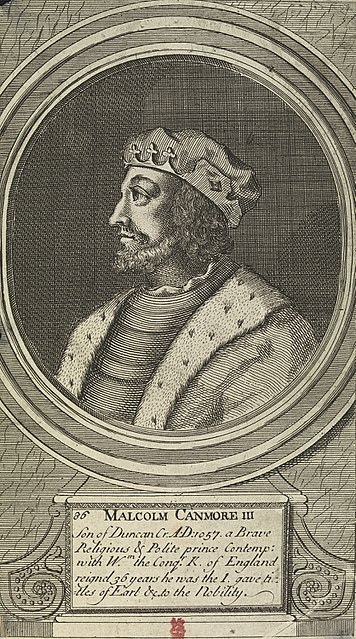
Malcolm (Dunkeld) of Scotland (abt. 1031 – 1093) 28th G-Grandfather. On 27 Jul 1054 Malcom avenged his family and took the crown by slaying Macbeth, who killed his father, Duncan I. Malcolm was the son of Duncan I who was killed by Macbeth in 1040. He found safe haven in Northumbria and the support of its ruler Earl Siward, who led an army against Macbeth in 1054. Siward and Malcolm defeated Macbeth at the battle of Dunsinnan but although Malcolm’s lands were restored to him, he did not dislodge Macbeth from the throne. It wasn’t until three years later, on 15 August 1057 at the battle of Lumphanan, that Malcolm again defeated Macbeth. But it was Lulach, Macbeth’s stepson and cousin who became king. After less than four months however, Malcolm had Lulach killed and replaced him on the Scottish throne.
Malcolm’s rule was marked by many changes when bringing the culture and civilization of England to Scotland. In 1071 however, his reign overcome when Scotland was invaded by William the Conqeror of England who forced Malcolm to pay him homage at Abernethy in Perthshire.
In 1072 he submitted to William I, king of England. In 1078 he defeated Lulach’s son Mael Snechta.
His oath to William didn’t prevent him from raiding Northumbria on a regular basis and it was while on such a raid, in August 1093, that he laid the foundation stone of Durham cathedral.
In Nov 1093 he was killed raiding Alnwick. Much of Malcolm’s reign was spent pursuing his claim to Northumbria. On his last raid on Northumbria in 1093, he and his son were killed in a treacherous ambush. The king was 63.
During his reign, Scotland became more European and cosmopolitan in outlook, due in large part to the Hungarian-raised Queen Margaret. Malcolm was succeeded by his son Edgar, who was killed in battle during the siege of Alnwick Castle, Northumberland, England.
Malcom was initially buried at Tynemouth, but his son, King Alexander I, later removed his body to Dunfermline, Fife (Scotland). His widow, Margaret, died at Edinburgh Castle 16 Nov. 1093, and was buried before the high altar in the church of the Holy Trinity at Dunfermline, Fife. (Wikipedia) In 1250 (Margaret’s) body and that of her husband were exhumed and placed in a new shrine in the Abbey. In 1560 Mary Queen of Scots had Margaret’s head removed to Edinburgh Castle as a relic to assist her in childbirth.
In 1597 the head ended up with the Jesuits at the Scots’ College, Douai, France, but was lost during the French Revolution. Philip II of Spain had the other remains of Margaret and her husband Malcolm transferred to the Escorial in Madrid (royal mausoleum), but they cannot now be found.
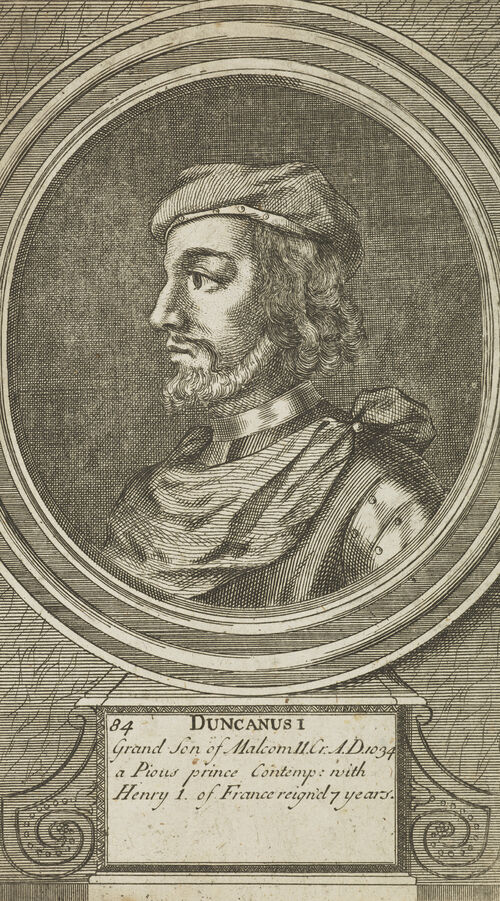
Duncan (Dunkeld) of Scotland (1007 – 1040) 29th G-Grandfather
He was son of Crínán, hereditary lay abbot of Dunkeld, and Bethóc, daughter of king Máel Coluim mac Cináeda (Malcolm II).
Unlike the “King Duncan” of Shakespeare’s Macbeth, the historical Duncan appears to have been a young man. He followed his grandfather Malcolm as king after the latter’s death on 25 November 1034, without apparent opposition. He may have been Malcolm’s acknowledged successor or Tànaiste as the succession appears to have been uneventful.
An earlier source, a variant of the Chronicle of the Kings of Alba (CK-I), gives Duncan’s wife the Gaelic name Suthen. Whatever his wife’s name may have been, Duncan had at least two sons. The eldest, Malcolm III (Máel Coluim mac Donnchada) was king from 1058 to 1093, the second Donald III (Domnall Bán, or “Donalbane”) was king afterwards.
The early period of Duncan’s reign was apparently uneventful, perhaps a consequence of his youth. Macbeth (Mac Bethad mac Findláich) is recorded as having been his dux, today rendered as “duke” and meaning nothing more than the rank between prince and marquess, but then still having the Roman meaning of “war leader”.
In context — “dukes of Francia” had half a century before replaced the Carolingian kings of the Franks and in England the over-mighty Godwin of Wessex was called a dux — this suggests that Macbeth may have been the power behind the throne.
In 1039, Duncan led a large Scots army south to besiege Durham, but the expedition ended in disaster. Duncan survived, but the following year he led an army north into Moray, Macbeth’s domain, apparently on a punitive expedition against Moray. There he was killed in action, at Bothnagowan, now Pitgaveny, near Elgin, by the men of Moray led by Macbeth, probably on 14 August 1040. He is thought to have been buried at Elgin before later relocation to the Isle of Iona.
Duncan was a hemophiliac who bled to death after fighting with MacBeth. In 1034 Malcolm’s grandson Duncan I succeeded him, but in 1040 he was killed by Macbeth, who contrary to Shakespearian legend ruled well and wisely for seventeen years, extending Scotland’s connections with England and the Continent, until defeated and killed by Duncan’s son, Malcolm III, known as Malcolm Canmore.
Duncan (Dunkeld) of Dunkeld (0949 – aft. 0990) 30th G-Grandfather
Duncan commanded the Scottish left wing at the battle of Luncarty (c990) where the Danes were so crushingly defeated that their raids on that part of what subsequently became Perthshire, hitherto periodic and devastating, were terminated; had (Crinan), with two younger sons ((1) Grim, Thane (hereditary tenant of the Crown) of Strathearn (west of Perth) and Baille (functionary with judicial powers) of Dule, killed 1010 at Battle of Mortlach, where Malcolm II King of Scots defeated invading Norsemen; (2) Duncan, ancestor of the Irving’s of Dumfries and Forbes Irvine’s of Drum). [Burke’s Peerage]
Dumferline Anglican Church & Graveyard were the first to be built in Scotland in 0932. It has been refurbished and rebuilt over the centuries. Duncan is buried there.
Duncan Dún Caillen (abt. 0920 – abt. 0965) 31st G-Grandfather
The profile represents Duncan Macdonachadh, hereditary lay Abbot of Dunkeld, Archpriest of the Kindred of St. Columba. He was born c. 920 and died 965. Duncan was killed in the year 965 His wife may have been a daughter of one of the last Kings of the Isles.
Duncan was killed in battle fighting overthrow of King Duff. Records state the hereditary Abbots of Dunkeld, specifically Duncan, killed in 965 AD. were the senior branch of the kin of St. Columba (521 AD- 597 AD) who was descended from Conal Gulban in the 3rd degree (great grandson) thus establishing the Lakeys are also descended of Conal Gulban. Abbot Duncan was descended from Conal Gulban in the 15th degree. Records from Scotland state the family was in Scotland as early as 650 in the Dumbatton -Loch Lomond area.
Clan Ross
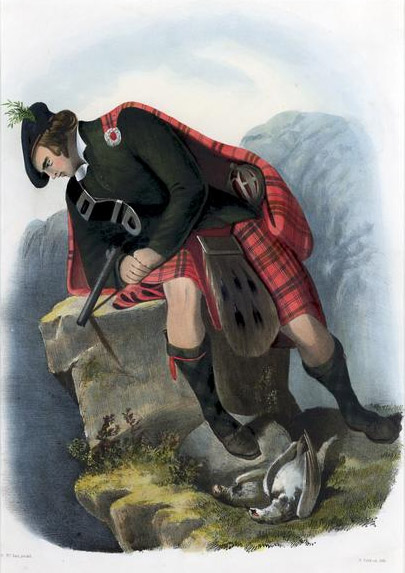
We are descended from Clan Ross through the Andrew Family
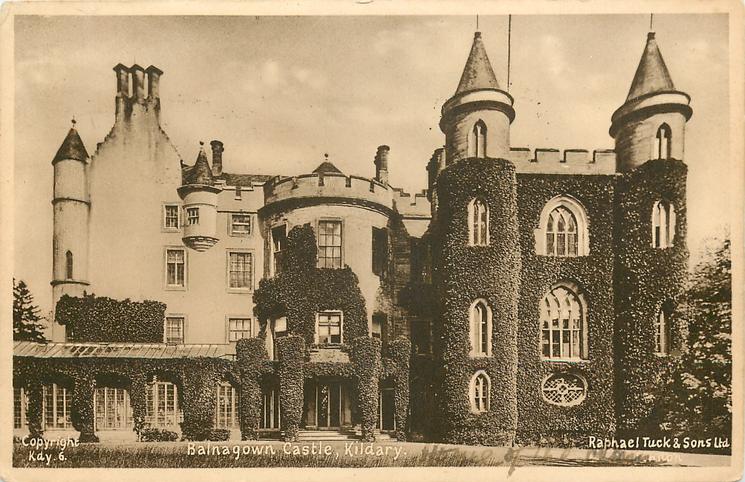
From Wikipedia: “Balnagown Castle is located beside the village of Kildary in Easter Ross, part of the Highland area of Scotland. There has been a castle on the site since the 14th century, although the present building was remodeled in the 18th and 19th centuries. Balnagown is the ancestral home of the Chiefs of Clan Ross, although since the 1970s it has been owned by the Egyptian-born businessman Mohamed Al-Fayed. The castle is protected as a category B listed building, and the grounds are included on the Inventory of Gardens and Designed Landscapes in Scotland, the national listing of significant gardens.
In the early 14th century, a castle was begun at Balnagown by Hugh, Mormaer (Earl) of Ross. Hugh was husband of Maud, sister of King Robert the Bruce, although after Hugh’s death in 1333, his family lost royal favour and their lands were forfeit. Balnagown was acquired by a stepson of Hugh in 1375 who expanded the estate, a process which continued over the following centuries. On 11 November 1501 James IV was entertained by the laird’s harper. In 1585 Alexander Ross, 9th laird of Balnagown, was outlawed, as was his son George.
During the Wars of the Three Kingdoms, David Ross, 12th of Balnagown, fought for King Charles II at the Battle of Worcester (1651), although he was captured and died in the Tower of London. The 13th laird, another David, married Anne, daughter of James Stuart, 4th Earl of Moray, in 1666.[4] David and Anne rebuilt Balnagown, as attested by a datestone of 1672 on the castle, although they left no heir, and the estate passed to the Rosses of Halkhead in 1711.
In 1754, Balnagown passed to another branch of the family, when it was inherited by Admiral Sir John Lockhart-Ross, 6th Baronet. The admiral spent much time and money improving the Balnagown estate, becoming “the most efficient and enterprising Highland estate manager of his day.” His son and heir Sir Charles Lockhart-Ross consulted James Gillespie Graham on Gothic Revival style alterations to the castle, and Italian gardens were laid out. Sir Charles Ross, 9th Baronet, inherited in 1911. He continued the tradition of agricultural improvement, introducing the silo and the combine harvester to the estate. He also invented the Ross rifle, which he had manufactured in Canada. To prevent the seizure of Balnagown by the Inland Revenue, Ross had the estate declared a ward of the court of Delaware, and he was subsequently unable to return to Britain for fear of imprisonment. From his death in 1942, until 1972, the castle was unoccupied and became dilapidated. In 1972, it was purchased by Mohamed Al-Fayed, who began restoration of the house and grounds.”